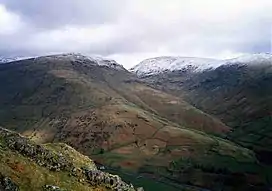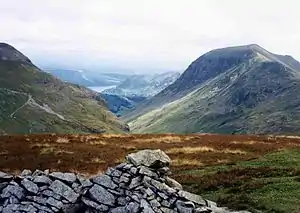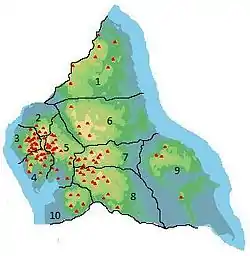| Seat Sandal | |
|---|---|
 Seat Sandal (left) and Fairfield (right) seen from Helm Crag 2 km to the SW. | |
| Highest point | |
| Elevation | 736 m (2,415 ft) |
| Prominence | c. 150 m |
| Parent peak | Fairfield |
| Listing | Hewitt, Marilyn, Nuttall, Wainwright |
| Coordinates | 54°29′40″N 3°00′57″W / 54.49456°N 3.01585°W |
| Geography | |
 Seat Sandal Location in Lake District, UK | |
| Location | Cumbria, England |
| Parent range | Lake District, Eastern Fells |
| OS grid | NY343115 |
| Topo map | OS Landranger 90 OS Explorer 5 |
Seat Sandal is a fell in the English Lake District, situated four kilometres (2+1⁄2 miles) north of the village of Grasmere from where it is very well seen. Nevertheless, it tends to be overshadowed by its more illustrious neighbours in the Eastern Fells, Helvellyn and Fairfield.
Name
The unusual name comes from the Old Norse language, " Sandulfr " being an Old Norse personal name.[1]
The name element ' Seat ' is from Old Norse ' sæter ' . [lower-alpha 1]
Toponym
- Sandulfr's sæter
- Sandal's high summer pasture. [lower-alpha 2] [lower-alpha 3]
Examples of place names with a similar etymology might include :
- Seatoller , Borrowdale, Lake District : (Seat..oller ) " Óláfr’s sæter "
- Seatallan , Wasdale, Lake District : (Seat..allan ) " Aleyn's sæter "
The remains of structures have been found on Seat Sandal that are assumed to have been summer shielings (high altitude dwellings ) where people stayed during the summer months in order to watch over the animals. [lower-alpha 4] [lower-alpha 5] [lower-alpha 6]
Both Seat Sandal and Seatoller (Seat..oller ) are positioned on historic routes that traverse across the heart of the Lake District, suggesting that these were important strategic places. [lower-alpha 7] [lower-alpha 8]
Topography

The fell's western flanks above Dunmail Raise are grassy and smooth while its eastern slopes are steep and craggy as they fall away towards Grisedale Hause which at 537 m (1,762 ft) contains Lakeland's highest substantial tarn, Grisedale Tarn. The fell reaches a height of 736 m (2,415 ft) and just scrapes into the list of Marilyns by being given prominence of ‘around’ 150 metres from the higher fell of Fairfield. However, this must be regarded as a borderline case as there is no Ordnance Survey surveyed height for the top of Grisedale Hause. Alfred Wainwright gives it a height of 1,929 feet (588 metres) giving Seat Sandal a topographic prominence of only 148 metres (two metres short of Marilyn qualification).
Seat Sandal is distinctive in that its drainage reaches the sea at more widely spread points than any other Lakeland Fell, with Raise Beck going through Thirlmere and Derwent Water to reach the Irish Sea at Workington, Tongue Beck going through the lakes of Grasmere and Windermere to reach Morecambe Bay and Grisedale Beck draining into Ullswater and then to the sea at the Solway Firth. However, this is true only as a result of the diversion of Raise Beck north to feed Thirlmere Reservoir — before this (and still today when there is enough water in Raise Beck for it to flow both north and south), Dollywaggon Pike shared in this distinction — Birkside Gill feeding Thirlmere, Raise Beck feeding Grasmere, and Grisedale Beck feeding Ullswater. The fell's main topographic attraction is Gavel Crag on its eastern side, which is connected to the main body of the fell by a fine rock arête.
Dunmail Raise provides the topographical connection between the Eastern and Central Fells, Steel Fell rising on the other side of the pass.
Geology
A hill of andesite lava forms the summit, the rocks beneath being the dacitic lapilli-tuffs of the Lincomb Tarns Formation.[8]
Ascents
The fell can be ascended from Grasmere or Dunmail Raise although a start from Patterdale is quite feasible. The Grasmere or Patterdale starts use the old packhorse route that links the two places; this is now part of Wainwright's Coast to Coast Walk. When Grisedale Hause is reached it is a steep climb to the summit following a broken wall. The ascent from Dunmail Raise follows the bed of Raise Beck until it peters out at a height of 580 m (1,900 ft); it is then a walk south up easy slopes to reach the summit. There is also a direct ascent up the western slopes starting at Mill Bridge.
Summit
The view from the top is limited by the nearby Helvellyn and Fairfield ranges although there is a good view of Lakeland to the west; the Solway Firth and Criffel are seen on a good day as is Morecambe Bay to the south.
References
Notes
- ↑ Definition of Old Norse ' sæter '
- ↑ " Sandal " is an anglicisation of the Old Norse personal name " Sandulfr "
- ↑ Olaf Sandal : The Viking ruler Olaf Sihtricson, King of Northumbria (r. 941 – 943 ), was also known as " Olaf Sandal " .[5]
- ↑ Summer shielings : " ...historical sites ...Little Langdale ...Seat Sandal " .[6]
- ↑ Summer transhumance " We know from the evidence of Norse farming customs in north Scotland that Norse settlers in Britain continued the system of summer transhumance which was customary in their Scandinavian homeland. " [6]
- ↑ See Transhumance > Scandinavian peninsula
- ↑ Historic Routes : The routes that the Scandinavian settlers might have used are mirrored by Wainwrights's Coast to Coast Walk from St Bees Head to Keld :[7]
- Buttermere to Borrowdale (via Seat..oller )
- Borrowdale to Patterdale (via Seat Sandal )
- ↑ It would be expected that meat and perhaps dairy might have been traded at these locations.
Citations
- ↑ Nordic Names : Sandulfr
- ↑ Reaney 1969, p. 174.
- ↑ Rollinson 1981, p. 34.
- ↑ Gambles 1997, p. 4.
- ↑ Williams 2017, p. 290.
- 1 2 Gambles 1997, p. 154.
- ↑ OS Maps 2000, p. 1.
- ↑ British Geological Survey: 1:50,000 series maps, England & Wales Sheet 29: BGS (1999)
Sources
Maps
- OS Maps (2000). Wainwrights's Coast to Coast Walk - St Bees Head to Keld. Ordnance Survey. ISBN 0-319-26090-9.
Books
- Williams, Thomas (2017). Viking Britain - A History. William Collins Books. ISBN 978-0-00-817195-7.
- Gambles, Robert (1997). The Story of the Lakeland Dales. Phillimore & Co Ltd. ISBN 1-86077-033-9.
- Rollinson, William (1981) [1974]. Life and Tradition in the Lake District. Dalesman. ISBN 0-85206-635-X.
- Reaney, P H (1969). The Origin of English Place Names. Routledge & Kegan Paul.
